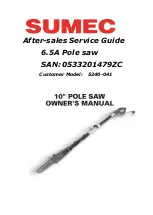
8
WARNING
To reduce the risk of electric shock,
check work area for hidden pipes
and wires before making pocket cuts.
Pocket Cutting
Pocket cuts are made in the middle of the workpiece
when it can not be cut from an edge. We recommend
using a Sawzall
®
reciprocating saw or jig saw for this
type of cut. However, if you must use a circular saw
to make a pocket cut, USE EXTREME CAUTION.
To maintain control of the saw during pocket cutting,
keep both hands on the saw.
1. Beginning at a corner, line up the sight line with
-
ing the front of the shoe on the workpiece. The
blade should be just above cutting line, but not
touching it. Raise the lower guard using the lower
guard lever.
2.
while pulling the trigger. Allow the motor to reach
full speed before beginning cut. Using the front
of the shoe as a hinge point, gradually lower the
back end of the saw into the workpiece. Release
the lower guard lever and grasp the front handle.
3.
-
vance the saw to the far corner. Release the trigger
and allow the blade to come to a complete stop
before removing it from workpiece. Repeat the
above steps for each side of the opening. Use a
Sawzall
®
reciprocating saw, jig saw or small hand
cut through.
Troubleshooting
If the blade does not follow a straight line:
• Teeth are dull. This is caused by hitting a hard object
such as a nail or stone, dulling teeth on one side. The
blade tends to cut to the side with the sharpest teeth.
• Shoe is out of line or bent
• Blade is bent
• Blade is loose.
If the blade binds, smokes or turns blue from friction:
• Blade is dull
• Blade is on backwards
• Blade is bent
• Blade is dirty
• Workpiece is not properly supported
• Incorrect blade is being used
• Battery charge is low
MAINTENANCE
WARNING
To reduce the risk of injury, always
unplug the charger and remove the
battery pack from the charger or tool before
performing any maintenance. Never disassemble
the tool, battery pack or charger. Contact a
MILWAUKEE®
service facility for ALL repairs.
Maintaining Tool
Keep your tool, battery pack and charger in good
repair by adopting a regular maintenance program.
Inspect your tool for issues such as undue noise,
misalignment or binding of moving parts, breakage of
operation. Return the tool, battery pack, and charger
to a
MILWAUKEE®
service facility for repair. After
six months to one year, depending on use, return the
tool, battery pack and charger to a
MILWAUKEE®
service facility for inspection.
If the tool does not start or operate at full power with
a fully charged battery pack, clean the contacts on
the battery pack. If the tool still does not work prop-
erly, return the tool, charger and battery pack, to a
MILWAUKEE®
service facility for repairs.
WARNING
To reduce the risk of personal in-
jury and damage, never immerse
your tool, battery pack or charger in liquid or
Cleaning
Clean dust and debris from vents. Keep handles
clean, dry and free of oil or grease. Use only mild
soap and a damp cloth to clean, since certain clean-
ing agents and solvents are harmful to plastics and
other insulated parts. Some of these include gasoline,
turpentine, lacquer thinner, paint thinner, chlorinated
cleaning solvents, ammonia and household deter-
combustible solvents around tools.
Repairs
For repairs, return the tool, battery pack and charger
to the nearest authorised service centre.
ACCESSORIES
WARNING
Use only recommended accesso-
ries. Others may be hazardous.
For a complete listing of accessories, go online to
milwaukeetool.com.au / milwaukeetool.co.nz or
contact a distributor.






























